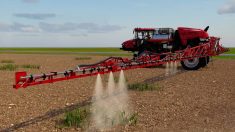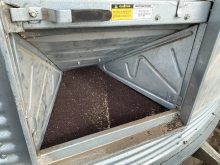Somali refugees seeking shelter in Kenya from extreme drought and hunger are the poorest of the poor and the most vulnerable in the world, the head of the UN refugee agency said.
Increasing numbers of malnourished young children are dying after trekking for weeks to receive emergency aid in what has become the “worst humanitarian disaster in the world,” UNHCR chief Antonio Guterres said.
“We ran because of starvation,” said Ulmay Abdow Issack, 32, who spent three weeks walking to the border with her six young children and sick husband. “We didn’t have anything to eat or drink on the journey.”
Read Also

Farm equipment sales sector sees significant structural changes
Farming equipment sales have been declining for a number of years now, and one industry professional believes structural changes in the industry are needed to curb that trend.
For Muslima Adan Hassan, 35, the journey was even more arduous. Two sons and a daughter died during their 35-day trek to Dadaab.
From the border, refugees have to travel 80 km across the Kenyan desert to reach the camp, often on foot.
“We have cases where children are eaten by hyenas and lions,” said Abdullahi Hussein Sheikh, one of the refugees.
In June, the number of new arrivals in Kenya’s Dadaab refugee camp tripled to 1,300 people each day. International agencies have been unable to provide food aid inside Somalia due to insecurity and hostility from the Islamist rebel group, al Shabaab, which controls much of the country.
“I have visited many refugee camps in the world. I have never seen people coming in such a desperate situation,” Guterres said on Sunday during a visit to the refugee camp, the world’s biggest, 80 km (50 miles) from the Kenya-Somali border.
“Here, in the outskirts of the Somali refugee camp of Dadaab, we have the poorest of the poor, the most vulnerable of the vulnerable in the world.”
Children and mothers sat in the sand, waiting for help, precious jerry cans of water their only possessions. Some babies cried; others were listless with exhaustion, their faces caked white with dust.
Deaths of children under five increased sixfold in May, compared to the previous year, in Dagahaley, the northern section of the camp. Between 18 and 24 per cent of new arrivals under five are malnourished.
“Many of the children are dying within 24 hours of arriving. They’re arriving, we’re screening them, we’re sending them to our feeding programs but even then it’s not soon enough to catch them,” Allison Oman, a nutritionist with UNHCR, said.
“Emergency within an emergency”
The Uni ted Nat ions has described the drought in the Horn of Africa as an emergency, one phase before famine. Some 10 million people are affected in a triangle straddling Kenya, Somalia and Ethiopia.
It says it is the worst drought in 60 years and almost a dozen aid agencies have launched massive appeals.
“I have not seen a situation like this personally since the 1991 famine in Southern Sudan,” Oman said.
Somalia has had no effective central government for two decades, worsening the impact of recurring droughts. Al Shabaab has refused to allow food aid to be delivered in areas under their control, saying it encourages dependency.
Earlier this month, al Shabaab made a U-turn and announced that humanitarian agencies were welcome in the country. The statement has been welcomed cautiously.
“It is absolutely essential to create the conditions for massive humanitarian aid to be distributed inside Somalia,” said Guterres, describing Dadaab as “an emergency within an emergency.”
He said al Shabaab’s new policy should be “tested and verified” as it could reduce people’s suffering and stop them fleeing.
Dadaab hosts 376,000 refugees but it was built to accommodate one-quarter of that in 1991. It was officially declared full in 2008.
Up to five families are sharing plots designed for one family, while an additional 42,000 people are squatting outside the camp.
The Kenyan government suspended plans to relocate thousands of refugees to a new site in October. It is concerned that militias use the camp to rest and recruit.
The situation is unlikely to improve before the onset of the rains season, which is expected in October.
“No single person will be remaining in Somalia if the drought continues like this,” said Kadijo Hassan, aged 50.
———
“Ihavevisitedmany refugeecampsinthe world.Ihavenever seenpeoplecoming insuchadesperate situation.”
Antonio Guterres UNHCR














